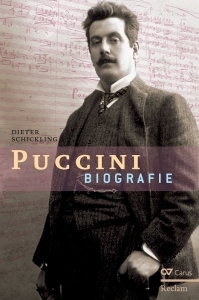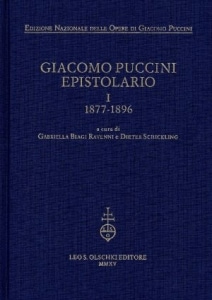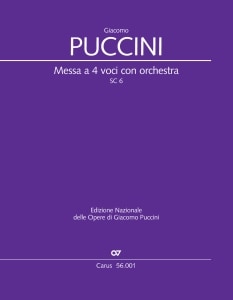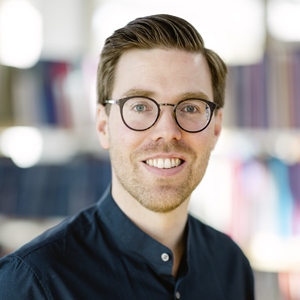Puccini Symposium
A conference report from 16 January 2024
Tuesday, 16 January 2024, will be remembered as an extraordinary day for its many scientific, artistic and personal contributions. To mark the first anniversary of the death of the well-known Puccini researcher Dieter Schickling from Stuttgart, Carus-Verlag together with the Centro Studi delle Opere di Giacomo Puccini and the Edizione Nazionale organized a symposium (held on the premises of Carus-Verlag) aimed at summarizing current research trends and projects, compiling joint projects and the achievements of the past years as well as peering into the future of Puccini research.
The event began with a warm welcome to representatives of the three most important institutions: Johannes Graulich, publisher and managing shareholder of Carus-Verlag, Gabriella Biagi Ravenni from Centro Studi and Virgilio Bernardoni from Edizione Nazionale.
The first topic on the symposium agenda was the material legacy of Dieter Schickling, the so-called “Schickling Collection”, which has since been inventoried and incorporated into the Centro Studi. Musicologist Marco Gallenga provided insight into the task of cataloging Schickling’s wide-ranging private library. The vast collection of over 1,700 books, playbills, journals, etc. demonstrated the versatility of Schickling as a researcher as well as underlining the significance of Puccini in his collecting activities. This treasure trove contains over 600 thematic publications. Manon Lescaut tops the hit-list of Puccini works with 34 publications dedicated to the opera. The many languages as well as the meticulously collected and annotated editions provide evidence of Schickling’s rigor, while also leading Marco Gallenga to a more far-reaching conclusion, namely that physical objects outlive any individual person and thus can serve as eternal sources of inspiration for future scholars.
In her lecture, Gabriella Biagi Ravenni referred to Schickling’s monograph on Puccini: Schickling’s work in retracing the life of the composer not only led him to important waystations in Puccini’s career, but also formed the basis for an edition of correspondence. Schickling edited around 4,000 letters, half of which had not previously been published. After the founding of the Centro Studi di Giacomo Puccini (1996), the project of producing volumes of correspondence, called the Epistolario, took a decisive step forward. What began as a printed collection at the end of the 1980s and in the 1990s has been successively digitized over recent years, also enabling the systemization of the data structure and search function. In 2011, the collection of correspondence encompassed 20,000 letters, some of which had been purchased by Dieter Schickling from private dealers. The audience at Ravenni’s lecture learnt of a direct link to Stuttgart in the form of a postcard of the city’s Solitude Palace (dated 1914), which Puccini had presumably bought during his visit the previous year.
In his short presentation, Giulio Battelli gave insight into research conducted on the source materials and manuscripts held in the collection of the Boccherini Conservatory (Lucca). The 22 Puccini manuscripts that Dieter Schickling bequeathed to the conservatory’s library also inspired him to visit the collection several times and to conduct extensive research into original documents. As an example, Battelli discussed Puccini’s Quartet in D major from 1882, which was reconstructed by Dieter Schickling together with Wolfgang Ludwig. As no coherent manuscript by Puccini could be identified, all the movements had to be located and compiled from various sources and copies. This editing process and the resulting piece were documented in a SWR2 radio series, featuring a performance by the Mannheim String Quartet and an interview with Dieter Schickling.
Siel Agugliaro supplemented these reflections on the scholarly editing of autographs and manuscripts with current insights into the digital cataloging of Puccini’s works and source references. With a demonstration of the beta version of the online database, he underlined the significance of Schickling’s printed and annotated catalog, which forms the basis of this digital resource. The obvious interactive advantages of the online catalog were pointed out: It enables, for example, the cross-referencing of manuscripts and printed editions while creative processes and scientific findings can be linked together.
An impressive chronicle, namely the path by which Carus-Verlag became a Puccini publisher, was outlined by chief editor Uwe Wolf, who discussed the process of editing the Messa a 4 voci con orchestra (Carus 56.001) and presented previously unknown editorial correspondence. A critical – and much anticipated – new edition was only successfully realized after two failed attempts when Dieter Schickling became the third and final editor. The editorial experience gained through the Edizione Nazionale (which was set up in 2007) has continued over the years. The latest volume to appear, featuring piano music, has been edited by the president of the Edizione Nazionale, Virgilio Bernardoni. During the lunch break of the symposium, an enthusiastic audience was treated to some first impressions of this edition by Stuttgart pianist Elisabeth Grünert.
In addition to the volumes of instrumental music, Andreas Gies also shared his thoughts on the methodology of producing critical opera editions, vividly illustrated by the example of Tosca. Such a critical edition is always tricky to produce due to the various stages and creative processes involved in writing both the libretto and the score. In particular, the following details must be taken into account: The autograph may contain errors that had to be corrected in later revisions; moreover, the printed score used in early performances should be understood as a “work in progress”. Gies thus advocates working backwards from the final (working) printed score annotated by the composer to the autograph in order to best assess the creative process and thus arrive at the ideal critical edition.
The final musicological impulse was provided by Deborah Burton (making a virtual appearance), who presented her newly reconstructed ending to the opera Turandot. Carefully addressing the existing versions of Puccini’s opera, she explained her critical approach to the original source material, also making reference to her correspondence with Dieter Schickling shortly before his death in January 2023.
All in all, the symposium shed light on the many different approaches to Puccini’s work as well as the interconnections and synergies that have arisen within the Carus-Verlag and which draw together Dieter Schickling’s spirit of research, the collaborations with the Edizione Nazionale and the Centro Studi as well as plans for new research projects and upcoming editions. This extraordinary day successfully launched the Puccini Year 2024 and provided the numerous guests with many intellectually stimulating ideas.
Dieter Schickling
Giacomo Puccini: monograph
Language: German
Carus 24.126
Epistolario I, 1877–1896
Edizione Nazionale Delle Opere di Giacomo Puccini
Carus 56.101
Messa a 4 voci con orchestra
Messa di Gloria, Edizione Nazionale delle Opere di Giacomo Puccini, III/2
SC 6
Carus 56.001/01 (paperback edition)
Exhibition hall of the Carus publishing house at the Puccini Symposium. Dr Johannes Graulich, Publisher and Managing Shareholder of Carus, presents the digitally connected Deborah Burton.
Further impressions of the Puccini Symposium can be found on Instagram.
Lorenz Adamer studied musicology and philosophy at the universities of Vienna (Austria), Cremona/Pavia (Italy) and Tübingen. In his spare time he is a keen clarinettist, and sings in a choir. He has been working at Carus-Verlag since summer 2017, initially as a sales assistant and now in the licensing department.









Leave a Reply
Want to join the discussion?Feel free to contribute!